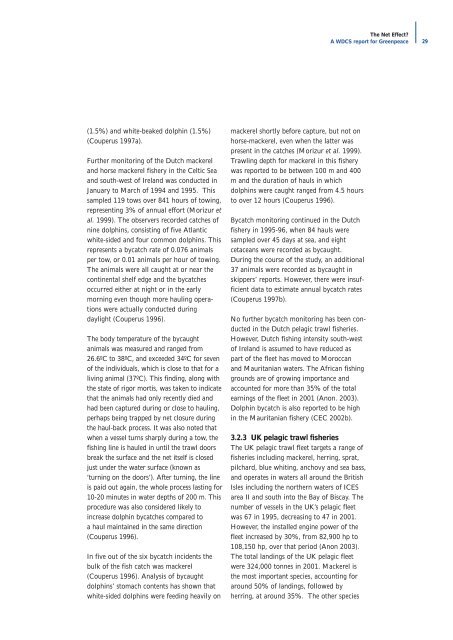The Net Effect? - Whale and Dolphin Conservation Society
The Net Effect? - Whale and Dolphin Conservation Society
The Net Effect? - Whale and Dolphin Conservation Society
You also want an ePaper? Increase the reach of your titles
YUMPU automatically turns print PDFs into web optimized ePapers that Google loves.
(1.5%) <strong>and</strong> white-beaked dolphin (1.5%)<br />
(Couperus 1997a).<br />
Further monitoring of the Dutch mackerel<br />
<strong>and</strong> horse mackerel fishery in the Celtic Sea<br />
<strong>and</strong> south-west of Irel<strong>and</strong> was conducted in<br />
January to March of 1994 <strong>and</strong> 1995. This<br />
sampled 119 tows over 841 hours of towing,<br />
representing 3% of annual effort (Morizur et<br />
al. 1999). <strong>The</strong> observers recorded catches of<br />
nine dolphins, consisting of five Atlantic<br />
white-sided <strong>and</strong> four common dolphins. This<br />
represents a bycatch rate of 0.076 animals<br />
per tow, or 0.01 animals per hour of towing.<br />
<strong>The</strong> animals were all caught at or near the<br />
continental shelf edge <strong>and</strong> the bycatches<br />
occurred either at night or in the early<br />
morning even though more hauling operations<br />
were actually conducted during<br />
daylight (Couperus 1996).<br />
<strong>The</strong> body temperature of the bycaught<br />
animals was measured <strong>and</strong> ranged from<br />
26.6ºC to 38ºC, <strong>and</strong> exceeded 34ºC for seven<br />
of the individuals, which is close to that for a<br />
living animal (37ºC). This finding, along with<br />
the state of rigor mortis, was taken to indicate<br />
that the animals had only recently died <strong>and</strong><br />
had been captured during or close to hauling,<br />
perhaps being trapped by net closure during<br />
the haul-back process. It was also noted that<br />
when a vessel turns sharply during a tow, the<br />
fishing line is hauled in until the trawl doors<br />
break the surface <strong>and</strong> the net itself is closed<br />
just under the water surface (known as<br />
‘turning on the doors’). After turning, the line<br />
is paid out again, the whole process lasting for<br />
10-20 minutes in water depths of 200 m. This<br />
procedure was also considered likely to<br />
increase dolphin bycatches compared to<br />
a haul maintained in the same direction<br />
(Couperus 1996).<br />
In five out of the six bycatch incidents the<br />
bulk of the fish catch was mackerel<br />
(Couperus 1996). Analysis of bycaught<br />
dolphins’ stomach contents has shown that<br />
white-sided dolphins were feeding heavily on<br />
mackerel shortly before capture, but not on<br />
horse-mackerel, even when the latter was<br />
present in the catches (Morizur et al. 1999).<br />
Trawling depth for mackerel in this fishery<br />
was reported to be between 100 m <strong>and</strong> 400<br />
m <strong>and</strong> the duration of hauls in which<br />
dolphins were caught ranged from 4.5 hours<br />
to over 12 hours (Couperus 1996).<br />
Bycatch monitoring continued in the Dutch<br />
fishery in 1995-96, when 84 hauls were<br />
sampled over 45 days at sea, <strong>and</strong> eight<br />
cetaceans were recorded as bycaught.<br />
During the course of the study, an additional<br />
37 animals were recorded as bycaught in<br />
skippers’ reports. However, there were insufficient<br />
data to estimate annual bycatch rates<br />
(Couperus 1997b).<br />
No further bycatch monitoring has been conducted<br />
in the Dutch pelagic trawl fisheries.<br />
However, Dutch fishing intensity south-west<br />
of Irel<strong>and</strong> is assumed to have reduced as<br />
part of the fleet has moved to Moroccan<br />
<strong>and</strong> Mauritanian waters. <strong>The</strong> African fishing<br />
grounds are of growing importance <strong>and</strong><br />
accounted for more than 35% of the total<br />
earnings of the fleet in 2001 (Anon. 2003).<br />
<strong>Dolphin</strong> bycatch is also reported to be high<br />
in the Mauritanian fishery (CEC 2002b).<br />
3.2.3 UK pelagic trawl fisheries<br />
<strong>The</strong> UK pelagic trawl fleet targets a range of<br />
fisheries including mackerel, herring, sprat,<br />
pilchard, blue whiting, anchovy <strong>and</strong> sea bass,<br />
<strong>and</strong> operates in waters all around the British<br />
Isles including the northern waters of ICES<br />
area II <strong>and</strong> south into the Bay of Biscay. <strong>The</strong><br />
number of vessels in the UK’s pelagic fleet<br />
was 67 in 1995, decreasing to 47 in 2001.<br />
However, the installed engine power of the<br />
fleet increased by 30%, from 82,900 hp to<br />
108,150 hp, over that period (Anon 2003).<br />
<strong>The</strong> total l<strong>and</strong>ings of the UK pelagic fleet<br />
were 324,000 tonnes in 2001. Mackerel is<br />
the most important species, accounting for<br />
around 50% of l<strong>and</strong>ings, followed by<br />
herring, at around 35%. <strong>The</strong> other species<br />
<strong>The</strong> <strong>Net</strong> <strong>Effect</strong>?<br />
A WDCS report for Greenpeace<br />
29

















